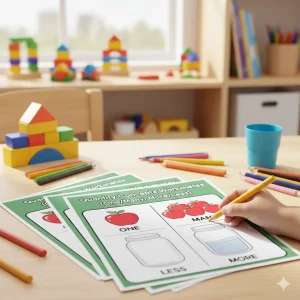Preventing Virtual Autism: Easy Strategies for Parents
By Wellness Hub
Last Updated: September 16, 2024
In today’s digital age, screens are everywhere—tablets, smartphones, TVs, and computers have become an integral part of our lives and, more importantly, our children’s lives. While technology brings many benefits, it also comes with challenges, especially for young, developing minds. One growing concern for parents is “Virtual Autism,” a condition linked to excessive screen time in young children. If you’ve ever wondered whether those extra hours in front of the screen could be affecting your child’s development, you’re not alone.
Understanding Virtual Autism
Definition
Virtual Autism happens when young children show Autism-like symptoms due to too much screen time. Unlike traditional Autism, which has many causes, Virtual Autism is mainly linked to spending a lot of time on screens, especially during the early years when kids are growing and learning the most.
Causes
The main cause of Virtual Autism is excessive screen time. This means spending long hours watching TV, using tablets, or playing on smartphones, especially without breaks or other activities. Young children need to interact with people, play, and explore their surroundings to develop properly. When screens take up too much time, they miss out on these important experiences.
Symptoms
Look out for these signs of Virtual Autism:
- Delayed Speech: Your child may struggle with talking or forming sentences.
- Social Withdrawal: They might prefer screens over playing with other kids or engaging with family members.
- Attention Problems: It can be hard for them to focus on anything other than screens.
Signs of Virtual Autism vs. Healthy Development
| Signs of Virtual Autism | Healthy Development | Explanation |
|---|
| Delayed Speech | Age-Appropriate Language Skills | Children may have trouble forming words, speaking in full sentences, or following simple instructions. In healthy development, children usually reach speech milestones on time, such as saying their first words around 12 months. |
| Prefers Screens Over People | Enjoys Playing with Others | A child with Virtual Autism may choose screens over interacting with family or peers, avoiding playtime and social games. In healthy development, children seek out social play and enjoy interacting with others. |
| Difficulty Focusing | Able to Engage in Various Activities | Children might have a hard time concentrating on tasks that don’t involve screens, showing restlessness or boredom quickly. Healthy children can focus on a variety of activities, such as playing with toys, reading, or participating in group activities. |
| Social Withdrawal | Shows Interest in Social Interactions | A child may avoid eye contact, not respond when spoken to, or seem uninterested in interacting with others. Healthy development is marked by curiosity about people, engaging in conversations, and playing with others. |
| Limited Interest in New Activities | Explores and Tries New Things | Children might stick to familiar screen-based activities and resist trying new, hands-on activities or games. Healthy children are often eager to explore their environment, learn new skills, and participate in diverse activities. |
| Repetitive Screen Use | Balanced Activity Engagement | Children may repeatedly watch the same videos or play the same games without exploring other activities. Healthy development includes a balance of screen time with physical play, creative tasks, and learning activities. |
Comprehensive Strategies to Prevent Virtual Autism
Preventing Virtual Autism is about finding a balance between screen time and other important activities. Here are some simple strategies that can help:
Set and Enforce Screen Time Limits
To prevent Virtual Autism, it’s crucial to set clear limits on screen time. For young children, aim for no screen time under 18 months, and about one hour per day for kids aged 2 to 5 years, with high-quality content. Be consistent with the rules, and use tools like timers or parental controls to help manage screen time.
Encourage Interactive and Creative Play
Kids learn best through play that involves others and sparks their imagination. Activities like puzzles, drawing, building blocks, and pretend play help develop important skills that screens can’t provide. Make time each day for hands-on play.
Model Healthy Screen Habits
Children copy what they see. Show good screen habits by limiting your own use, especially when you’re with your kids. Keep phones and tablets away during meals and family time to set a positive example.
Create Tech-Free Zones and Times
Designate areas like the dining room or bedrooms as tech-free zones. Also, set tech-free times, such as during meals or before bedtime, to encourage better routines and more family interaction.
Choose High-Quality Educational Content
When screen time is necessary, pick educational and age-appropriate content. Watch together with your child to make it more engaging and interactive, and talk about what you’re watching to reinforce learning.
Introduce Alternative Activities to Screens
Offer other activities like reading, playing with toys, outdoor play, or board games. Keep a variety of options available so your child has fun alternatives to screens when they’re looking for something to do.
Encourage Outdoor Play and Physical Activity
Outdoor play is great for both body and mind. Encourage your child to run, jump, climb, or just explore nature. These activities help develop motor skills, reduce stress, and promote a healthier lifestyle.
Promote Reading and Storytelling
Include reading and storytelling in your daily routine. Reading books together or telling stories can boost your child’s imagination, improve language skills, and increase attention spans.
Engage in Hands-On Learning Activities
Get your child involved in simple hands-on activities like cooking, gardening, or crafting. These activities teach practical skills, keep kids engaged, and reduce screen time naturally.
Facilitate Peer Interaction
Make time for your child to interact with other kids through playdates, group activities, or classes. Playing with others helps them learn important social skills like sharing, cooperation, and empathy.
Encourage Routine and Consistency
Kids do well with routines. Create a daily schedule that mixes screen time with other activities like play, reading, and outdoor time. Consistency helps children know what to expect each day.
Involve Children in Family Activities
Include your kids in everyday tasks like cooking, setting the table, or cleaning up. These activities teach responsibility and keep them engaged in real-life activities away from screens.
Educate Children About Screen Time
Talk to your kids about why screen time limits are important. When they understand the reasons, they’re more likely to follow the rules and make better choices.
Use Technology Purposefully
Encourage your child to use technology for learning or connecting with family, not just for watching videos. Purposeful use helps them see screens as tools, not just for entertainment.
Monitoring and Adjusting
Watch Your Child’s Progress
Keep an eye on your child’s behavior as you limit screen time. Are they talking more? Playing better with others? Paying attention? If things aren’t improving, try cutting screen time even more or adding new activities that encourage them to interact and play. Small changes can make a big difference!
Get Professional Help if Needed
If you’re still worried, it’s okay to ask for help. Talk to a doctor if your child isn’t showing progress. Early help is important, and a specialist can guide you on what steps to take next.
Conclusion
Preventing Virtual Autism is all about creating a good balance between screen time and other activities. You can do this by setting clear screen time limits, encouraging play that involves talking and moving, and having tech-free zones like during meals or bedtime. Watching how your child is doing and making changes when needed is key. If you still have concerns, don’t hesitate to talk to a doctor or specialist who can provide helpful advice.
Remember, small steps can make a big difference. Start today by picking one or two strategies to try, like reducing screen time or planning a fun, screen-free activity. Every bit helps, and you’re already making a positive impact by being involved. For more tips and support, visit WellnessHub where you’ll find resources and advice to help your child grow and thrive. You’re not alone—WellnessHub is here to support you every step of the way!
Frequently Asked Questions:
1. What is Virtual Autism?
Virtual Autism refers to Autism-like symptoms in young children that are linked to excessive screen time. Unlike traditional Autism, Virtual Autism is mainly caused by too much exposure to screens, which can impact a child’s development, including speech, social skills, and attention.
2. How can I prevent Virtual Autism in my child?
To prevent Virtual Autism, set clear screen time limits based on your child’s age, encourage interactive and creative play, and create tech-free zones in your home, like during meals or before bedtime. Involving your child in activities that don’t involve screens, like reading, outdoor play, and hands-on learning, also helps.
3. What are the symptoms of Virtual Autism?
Common symptoms of Virtual Autism include delayed speech, trouble focusing, and avoiding social interactions. If your child prefers screens over playing with others or has difficulty communicating, these might be signs that they are spending too much time on screens.
4. How much screen time is too much for young children?
For children under 18 months, it’s best to avoid screen time altogether, except for video chatting. For children aged 2 to 5 years, aim for no more than one hour of high-quality screen time per day. Older children should have balanced screen time with other healthy activities.
5. What are some alternatives to screen time for kids?
Great alternatives to screen time include playing with toys, reading books, doing puzzles, drawing, and outdoor activities like running or playing at the park. Encouraging your child to engage in these activities helps them develop important skills and reduces their reliance on screens.
6. When should I seek professional help for Virtual Autism?
If your child continues to show symptoms like delayed speech, social withdrawal, or attention issues despite reducing screen time, it’s a good idea to consult a pediatrician or a child development specialist. Early intervention can provide the right support and guidance for your child’s needs.
7. Can Virtual Autism be reversed?
Yes, Virtual Autism can often be improved or reversed by reducing screen time and increasing activities that promote interaction and learning. The sooner you take action, the better the chances of seeing positive changes in your child’s development.
8. How does screen time affect a child’s brain development?
Excessive screen time can affect a child’s brain development by reducing opportunities for face-to-face interactions, which are crucial for learning social and communication skills. It can also impact attention span and the ability to engage in real-world activities.
9. How can I make screen time educational for my child?
Choose high-quality, educational content that encourages learning and interaction, like shows that teach numbers, letters, or problem-solving skills. Watching and discussing content together with your child also makes screen time more meaningful and engaging.
10. How can I encourage my child to play more and use screens less?
Create a routine that includes plenty of playtime, outdoor activities, and other fun, screen-free options. Setting up specific times for screens and sticking to them can help, as well as modeling good screen habits yourself.
About the Author:
Anuradha Karanam
Speech-language pathologist (7+ years of experience)
Anuradha Karanam is a skilled speech-language pathologist with over 6 years of experience. Fluent in Tamil, Telugu, Hindi, and English, she specializes in parent counseling, speech sound disorders, fluency assessment, and speech-language evaluations. Anuradha excels at working with children with developmental disorders, offering creative and effective therapy programs. Currently, at Wellness Hub, she holds a BASLP degree and is registered with the RCI (CRR No A85500). Her patience, ambition, and dedication make her a trusted expert in her field.
Book your Free Consultation Today
Parent/Caregiver Info:
Client’s Details:
* Error Message









